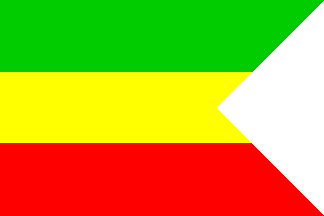
Last modified: 2011-04-01 by andrew weeks
Keywords: komarno | swallowtail | komarom | castle |
Links: FOTW homepage |
search |
disclaimer and copyright |
write us |
mirrors
See also:
 submitted through Rob Raeside, 20 July 1999
submitted through Rob Raeside, 20 July 1999
Komárno (in Hungarian: Komárom) has 37.346 inhabitants (63,6% Hungarian;
1990 census). The town was in Komárom (in Slovakian Komárno) County of
Hungary till 1919/1920 (Czechoslovakian occupation). 1920-1938 Czechoslovakian,
1938-1944 Hungarian (after the Decision of Vienna). The Treaty of Paris
(1947) reallocated it to Czechoslovakia. The city was the biggest fortress
in Central Europe
István Molnár, 12 June 2000
![[Komárno 1941 flag]](../images/s/sk-kn41.gif) by Jan Kravčík, 13 June 2000
by Jan Kravčík, 13 June 2000
In 1941 S. Széll mentioned the flag with the red-yellow-green order
of stripes and without the coat of arms.
Source: 'Városaink neve, címere és lobogója' by S. Széll, Budapest
1941.
Jan Kravčík, 13 June 2000
![[Komárno 1979 flag]](../images/s/sk-kn79.gif) by Jan Kravčík, 13 June 2000
by Jan Kravčík, 13 June 2000
The flag of the city in 1979. The original coat of arms used on the
flag in the past until 1945 was replaced in 1976 by modifed arms put into
the circular field with the description KOMÁRNO. On the obverse side is
a blue circular field with the symbols of a socialist city - white ship
(representing the docks), blue rivers (junction of Váh and Danube), yellow
wheat ear and white and red rectangle (representing urban development).
Source: 'Klíc k našim mestum', by Karel Liška and Ludvík Mucha,
Práce (ed), Prague, 1979
Jan Kravčík, 13 June 2000
![[Komárno Coat of Arms]](../images/s/sk)komar.jpg) from Ralf Hartemink's
site.
from Ralf Hartemink's
site.
The arms first appear in the seal of the city from the first half of
the 15th century, and are a typical image for a city. To distinguish the
composition from those of other cities the two stars were added. The arms
were officially granted in 1745, with the castle now placed on an island
between the two rivers Danube and Waag. The arms have not changed since.
Jarig Bakker